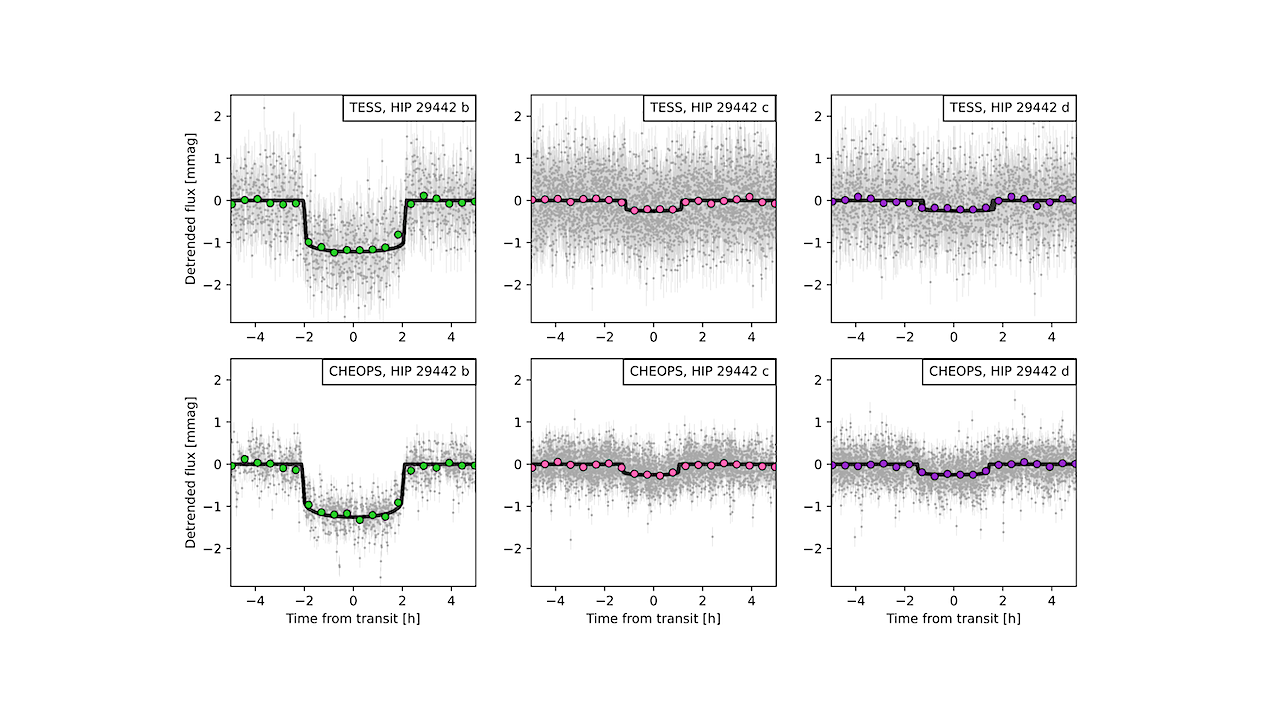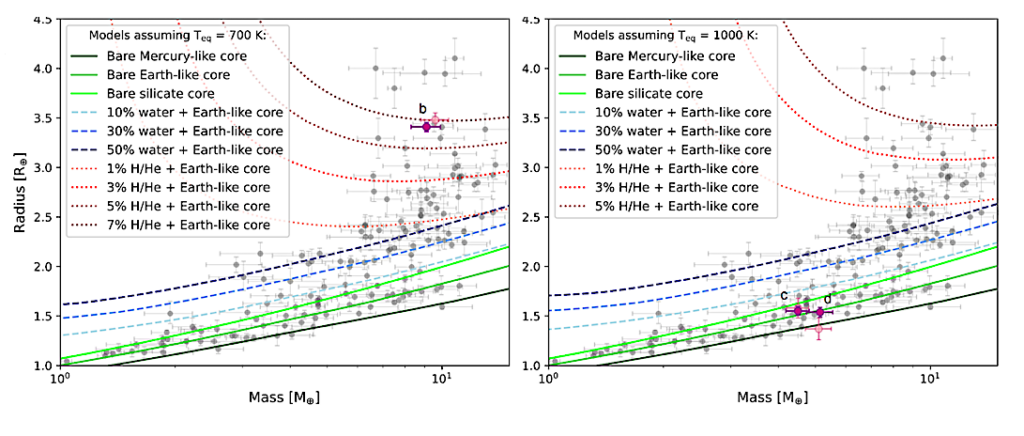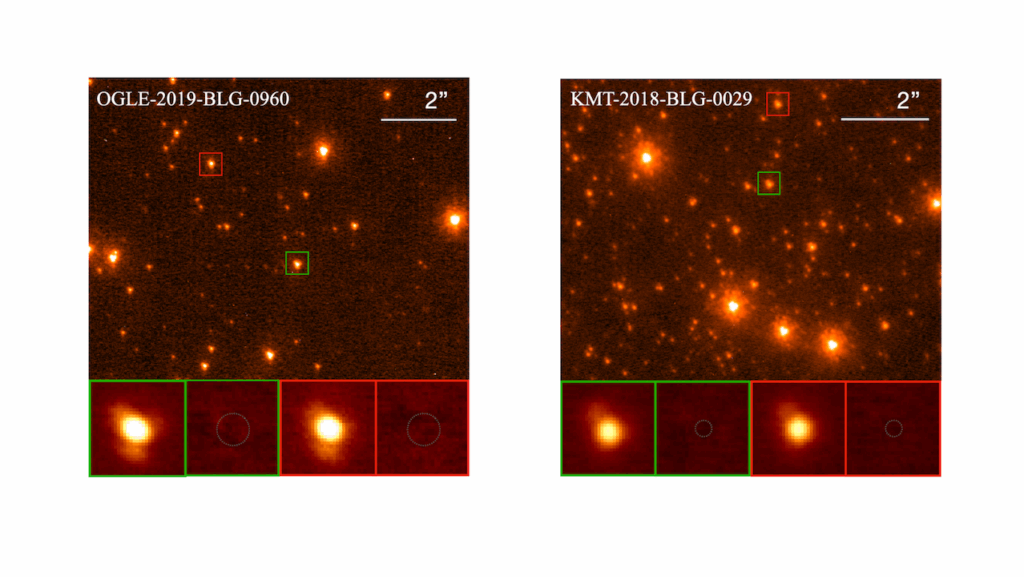Unveiling the Internal Structure And Formation History Of The Three Planets Transiting HIP 29442 (TOI-469) With CHEOPS

Multiplanetary systems spanning the radius valley are ideal testing grounds for exploring the proposed explanations for the observed bimodality in the radius distribution of close-in exoplanets. One such system is HIP 29442 (TOI-469), an evolved K0V star hosting two super-Earths and a sub-Neptune.
We observe HIP 29442 with CHEOPS for a total of 9.6 days, which we model jointly with 2 sectors of TESS data to derive planetary radii of 3.410±0.046, 1.551±0.045 and 1.538±0.049 R⊕ for planets b, c and d, which orbit HIP 29442 with periods of 13.6, 3.5 and 6.4 days. For planet d, this value deviates by more than 3 sigma from the median value reported in the discovery paper, leading us to conclude that caution is required when using TESS photometry to determine the radii of small planets with low per-transit S/N and large gaps between observations.
Given the high precision of these new radii, combining them with published RVs from ESPRESSO and HIRES provides us with ideal conditions to investigate the internal structure and formation pathways of the planets in the system.
We introduce the publicly available code plaNETic, a fast and robust neural network-based Bayesian internal structure modelling framework. We then apply hydrodynamic models to explore the upper atmospheric properties of these inferred structures.
Finally, we identify planetary system analogues in a synthetic population generated with the Bern model for planet formation and evolution. Based on this analysis, we find that the planets likely formed on opposing sides of the water iceline from a protoplanetary disk with an intermediate solid mass.
We finally report that the observed parameters of the HIP 29442 system are compatible with both a scenario where the second peak in the bimodal radius distribution corresponds to sub-Neptunes with a pure H/He envelope as well as a scenario with water-rich sub-Neptunes.

Mass-radius diagrams showing the locations of HIP 29442 b (left panel) and HIP 29442 c and d (right panel), in relation to the known exoplanet population. The transparent pink points show the planetary parameters derived by Damasso et al. (2023). Mass-radius relations for fixed compositions and equilibrium temperatures were generated using BICEPS (Haldemann et al. 2024). Shown are three different compositions for bare cores (solid lines in different shades of green), Earth-like cores with different amounts of water (dashed lines in different shades of blue) and with different amounts of H/He (dotted lines in different shades of red). Models in the left panel were calculated assuming an equilibrium temperature of 700 K (similar to HIP 29442 b), while models in the right panel were calculated assuming an equilibrium temperature of 1000 K (similar to HIP 29442 c and d). — astro-ph.EP
J. A. Egger, H. P. Osborn, D. Kubyshkina, C. Mordasini, Y. Alibert, M. N. Günther, M. Lendl, A. Brandeker, A. Heitzmann, A. Leleu, M. Damasso, A. Bonfanti, T. G. Wilson, S. G. Sousa, J. Haldemann, L. Delrez, M. J. Hooton, T. Zingales, R. Luque, R. Alonso, J. Asquier, T. Bárczy, D. Barrado Navascues, S. C. C. Barros, W. Baumjohann, W. Benz, N. Billot, L. Borsato, C. Broeg, M. Buder, A. Castro-González, A. Collier Cameron, A. C. M. Correia, D. Cortes, Sz. Csizmadia, P. E. Cubillos, M. B. Davies, M. Deleuil, A. Deline, O. D. S. Demangeon, B.-O. Demory, A. Derekas, B. Edwards, D. Ehrenreich, A. Erikson, A. Fortier, L. Fossati, M. Fridlund, D. Gandolfi, K. Gazeas, M. Gillon, M. Güdel, Ch. Helling, K. G. Isaak, L. L. Kiss, J. Korth, K. W. F. Lam, J. Laskar, B. Lavie, A. Lecavelier des Etangs, C. Lovis, A. Luntzer, D. Magrin, P. F. L. Maxted, B. Merín, M. Munari, V. Nascimbeni, G. Olofsson, R. Ottensamer, I. Pagano, E. Pallé, G. Peter, D. Piazza, G. Piotto, D. Pollacco, D. Queloz, R. Ragazzoni, N. Rando, H. Rauer, I. Ribas, J. Rodrigues, N. C. Santos, G. Scandariato, D. Ségransan, A. E. Simon, A. M. S. Smith, M. Stalport, S. Sulis, Gy. M. Szabó, S. Udry, V. Van Grootel, J. Venturini, E. Villaver, N. A. Walton
Comments: 30 pages, 17 figures, accepted for publication in A&A
Subjects: Earth and Planetary Astrophysics (astro-ph.EP)
Cite as: arXiv:2406.18653 [astro-ph.EP] (or arXiv:2406.18653v1 [astro-ph.EP] for this version)
Submission history
From: Jo Ann Egger
[v1] Wed, 26 Jun 2024 18:00:07 UTC (5,414 KB)
https://arxiv.org/abs/2406.18653
Astrobiology,








